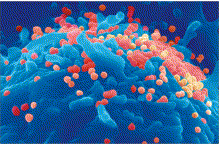| |
A cure for HIV: where we've been, and where we're headed
|
| |
| |
Download the PDF here
Sharon R Lewin a
The Lancet 15 June 2013
2013 marks the 30th anniversary of the discovery of HIV.130 Years of HIV Science: Imagine the Future, a meeting at the Pasteur Institute in Paris, France, in May, 2013, sought to celebrate successes in countering the HIV/AIDS epidemic and to map out the challenges ahead.
The successes have been spectacular. Antiretroviral therapy (ART) has transformed what was once a death sentence into a chronic manageable disease. ART not only prolongs life, but dramatically reduces HIV transmission. ART is now available to 8 million people living with HIV in low-income and middle-income countries.2 In 2011, the numbers of new infections declined by 50% in 25 countries-many in Africa, which has the largest burden of disease.2
These advances are a result of transformative science, advocacy, political commitment, and effective partnerships with affected communities.
However, substantial challenges exist to maintain access to and funding for lifelong ART to the more than 34 million people with HIV. The costs of delivering ART are overwhelming many organisations and public health systems; we must continue to search for alternatives to lifelong treatment to benefit patients at manageable costs to health systems. With that aim, the International AIDS Society (IAS) global scientific strategy,3 Towards An HIV Cure, was launched in 2012.
Reports of both sterilising cure (elimination of all HIV-infected cells) and functional cure (long-term control of HIV replication after ART) have raised hope that a cure for HIV can be achieved-at least in a subset of individuals. The first and only reported case of sterilising cure was Timothy Brown, the Berlin patient, an HIV-infected man given a bone marrow transplant for acute myeloid leukaemia. The donor was naturally resistant to HIV because of a mutation in the CCR5 gene-a critical protein required by HIV to enter and infect cells.4 Brown stopped ART very soon after transplantation and he remains free of HIV after 6 years.
The Mississippi baby seems to be the first case of functional cure of an infant due to ART given 30 h after birth.5 After 18 months, ART was stopped and the infant continues to have undetectable HIV in blood or tissue. Deborah Persaud and colleagues, who studied the baby, don't yet fully understand what cured the infant. Very early treatment might prevent formation of latent reservoirs for HIV, at least in an infant with an immature immune system. Careful follow up and further studies will be needed to see if this approach can be replicated in more infants, and then on a larger scale.
In the VISCONTI cohort,6 14 patients in France have maintained control of their HIV infection for a median of 7·5 years after ART interruption.6 These so-called post-treatment controllers were diagnosed and treated with ART during primary HIV infection (on average within 10 weeks after infection), for a median of 3 years before discontinuation. Patients in this cohort do not have the same distinct immunological profile seen in elite controllers, who naturally control HIV in the absence of ART.6 The VISCONTI study potentially shows the benefits of early ART on the size of the reservoir. Further studies of reservoir size in patients who initiate ART in chronic infection but with high CD4 counts are to be presented at IAS 2013, Kuala Lumpur, Malaysia (Hocqueloux, WEAB0102; Cheret, WEAB0101).
Bone marrow transplantation, from a donor without a mutation in CCR5, might substantially reduce or even eliminate the HIV reservoir. Two patients with lymphoma from Boston (MA, USA) were given chemotherapy, radiotherapy, and stem cell transplantation while on continuous ART. Several years after transplantation, HIV DNA had disappeared from both patients' blood and tissues.7 An update on the Boston patients is anticipated at IAS 2013 (Henrich, WELBA05).

Dr Olivier Schwartz, Institute Pasteur/Science Photo Library
HIV particles budding from host cell
The other approach to tackle HIV persistence in patients taking ART is to lure HIV out of its hiding place in resting T cells. Activating latent virus might lead to death of the cell or make the virus ready for immune-mediated clearance. A range of licensed drugs that modify gene expression, including viral gene expression, are in clinical trials in HIV-infected patients on ART. Two studies8, 9 have reported that HIV latency can be activated with the histone deacetylase inhibitor vorinostat.
There are now 15 HIV-cure-related trials being done worldwide.3 Clinical trials include investigations of increasingly potent histone deacetylase inhibitors, and of gene therapy to eliminate the CCR5 receptor from patient-derived cells.
HIV-cure-related trials raise many complex issues. Giving potentially toxic interventions to patients doing very well on ART needs careful assessment. At this early phase of research, participants will be unlikely to derive any direct benefits. Understanding risk-benefit, ethical issues, and the expectations and perspectives of the community will all be discussed and debated at IAS 2013 and the preceding IAS workshop, Towards an HIV Cure.
Developments towards a cure for HIV are exciting-for scientists, for clinicians, and most importantly, for patients. But we need to be realistic. Finding a cure will be a long and tough road, and will take many more years to achieve. We are at the very beginning, although many now believe that it might be possible to find a cure, at least for a small proportion of infected people.
We need to take inspiration from the many people who have delivered so much in the past 30 years, and continue to imagine, continue to innovate, and continue to work together towards an HIV cure-for everyone.
| |
| |
| |
|
|
|